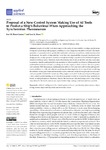Proposal of a New Control System Making Use of AI Tools to Predict a Ship’s Behaviour When Approaching the Synchronism Phenomenon

Use this link to cite
http://hdl.handle.net/2183/37247
Except where otherwise noted, this item's license is described as Creative Commons Attribution (CC BY) license (https:// creativecommons.org/licenses/by/ 4.0/)
Collections
Metadata
Show full item recordTitle
Proposal of a New Control System Making Use of AI Tools to Predict a Ship’s Behaviour When Approaching the Synchronism PhenomenonDate
2024Citation
Pérez-Canosa, J.M.; Orosa, J.A. Proposal of a New Control System Making Use of AI Tools to Predict a Ship’s Behaviour When Approaching the Synchronism Phenomenon. Appl. Sci. 2024, 14, 4517. https://doi.org/10.3390/app14114517
Abstract
[Abstract] In spite of the IMO’s efforts to improve the safety of intact stability on ships, synchronous rolling still causes large rolling angles, resulting in a very dangerous situation on board. The implementation of automatic tools to predict this undesirable situation has not been widely implemented. Furthermore, the safety of ship stability is not the only responsibility of people involved in the design process, so ship operators must have enough knowledge to predict and avoid these dangerous situations well in advance. Therefore, from a theoretical point of view, in the first part, this paper aims to present a valuable guiding tool for ship operators in order to predict synchronous rolling and avoid undesirable situations on board by making use of only empirical observations of the wave profile and moments. With this purpose, mathematical models are first proposed, with the ship sailing in the worst condition, i.e., with and without considering the damping factor, at zero speed and considering the influence of any pure beam and trochoidal waves. Relevant results shown provide the exact time and wave profile at which the maximum rolling angles are reached. In the second part of the paper, a new control system making use of AI tools is proposed in order to be used by ship operators on board, avoiding dangerous situations. Finally, the results are validated using a set of ship rolling simulations for the most common and representative ship loading conditions and wave periods.
Keywords
Artificial intelligence (AI)
Control system on board
Synchronism phenomenon
Ship’s rolling motion
Ship’s stability
Beam and trochoidal waves
Control system on board
Synchronism phenomenon
Ship’s rolling motion
Ship’s stability
Beam and trochoidal waves
Editor version
Rights
Creative Commons Attribution (CC BY) license (https:// creativecommons.org/licenses/by/ 4.0/)






